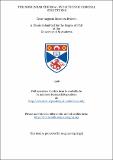Files in this item
The nonlinear thermal evolution of coronal structures
Item metadata
| dc.contributor.advisor | Hood, Alan W. | |
| dc.contributor.author | Mendoza Briceño, César Augusto | |
| dc.coverage.spatial | 140 p. | en_US |
| dc.date.accessioned | 2018-06-18T12:17:11Z | |
| dc.date.available | 2018-06-18T12:17:11Z | |
| dc.date.issued | 1996 | |
| dc.identifier.uri | https://hdl.handle.net/10023/14193 | |
| dc.description.abstract | The thermal equilibrium and evolution of coronal structure is studied in this thesis. A symmetric and constant cross-sectional coronal loop is considered and, because of the strong magnetic field, the plasma is confined to move along the field lines, so that a one-dimensional problem can be assumed. We begin by giving a brief description of the Sun and corresponding phenomena. Then a discussion of the basic MHD equations is given. Here, it is assumed that the heating function is spatially dependent and the cooling function is due to an optically thin plasma. The thermal equilibrium of uniform-pressure coronal loop is investigated. The effects due to varying the values of the parameters involved in the governing equations are studied. It is found that there is a critical decay length of the heating below which a hot coronal loop does not exist. It is suggested that thermal non-equilibrium occurs, allowing the existence of catastrophic cooling. A study of the stability of the equilibrium up to the second order approximation is presented, and it is found that the response of the structure not only depends on the amplitude of the disturbance, but also on whether the disturbance increases or decreases the static temperature. The thermal evolution of the above structure is also investigated by assuming that the inertial terms are small. The previous results related to the critical heating decay length are verified. The numerical simulation shows that an initial hot plasma evolves to a new equilibrium which has a cool summit. This equilibrium is identified as a prominence-like solution. Further investigations are made in order to show how the structure can either evolve to a hot or a cool summit temperature depending on whether the initial conditions are above or below threshold values. The evolution of a disturbance increasing or decreasing an initial equilibrium temperature is followed numerically verifying the prediction made in the stability analysis. Furthermore, the effect of gravity is considered in the thermal equilibrium of loop. Similar results were found as studied for a constant-pressure loop. However, it was found that the critical values in which thermal non-equilibrium can occur is increased. A magnetic dip is also included in this model and the thermal equilibrium is studied. Finally, extensions of the present work is presented and some preliminary results are discussed. | en_US |
| dc.language.iso | en | en_US |
| dc.publisher | University of St Andrews | en |
| dc.subject.lcc | QA927.M3 | |
| dc.subject.lcsh | Magnetohydrodynamics | en |
| dc.title | The nonlinear thermal evolution of coronal structures | en_US |
| dc.type | Thesis | en_US |
| dc.contributor.sponsor | University of St Andrews | en_US |
| dc.contributor.sponsor | Universidad de los Andes (Mérida, Venezuela) | en_US |
| dc.type.qualificationlevel | Doctoral | en_US |
| dc.type.qualificationname | PhD Doctor of Philosophy | en_US |
| dc.publisher.institution | The University of St Andrews | en_US |
This item appears in the following Collection(s)
Items in the St Andrews Research Repository are protected by copyright, with all rights reserved, unless otherwise indicated.

